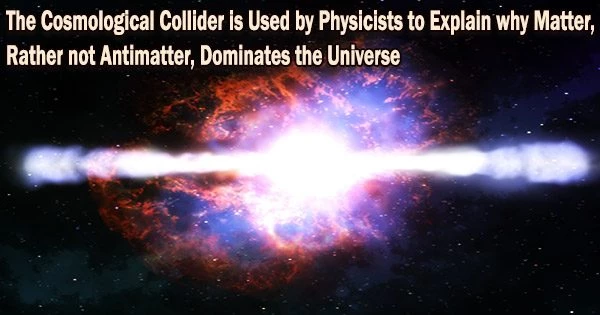The idea of a “cosmological collider” is a theoretical concept used to explain the observed asymmetry between matter and antimatter in the universe. According to the current understanding of physics, matter and antimatter should have been created in equal amounts during the Big Bang.
The universe was initially composed equally of matter and “antimatter” particles, which are similar to matter particles but have the opposite charge, immediately after the Big Bang. However, as space continued to expand, the universe cooled.
Today’s universe is full of galaxies and stars which are made of matter. Where did the antimatter go, and how did matter come to dominate the universe? This cosmic origin of matter continues to puzzle scientists.
By using the “cosmological collider,” physicists at the University of California, Riverside and Tsinghua University in China have now created a novel technique to investigate the genesis of matter in the universe.
Not just any collider
High energy colliders, such as the Large Hadron Collider, have been built to produce very heavy subatomic elementary particles that may reveal new physics. However, some novel physics, like that describing dark matter and the creation of matter, can entail far heavier particles and require much higher energy than what a collider created by humans can provide. It turns out that such a super-collider could have existed in the early universe.
Yanou Cui, an associate professor of physics and astronomy at UCR, explained that it is widely believed that cosmic inflation, an era when the universe expanded at an exponentially accelerating rate, preceded the Big Bang.
“Cosmic inflation provided a highly energetic environment, enabling the production of heavy new particles as well as their interactions,” Cui said. “The inflationary universe behaved just like a cosmological collider, except that the energy was up to 10 billion times larger than any human-made collider.”
The fact that our current-day universe is dominated by matter remains among the most perplexing, longstanding mysteries in modern physics. A subtle imbalance or asymmetry between matter and antimatter in the early universe is required to achieve today’s matter dominance but cannot be realized within the known framework of fundamental physics.
Professor Yanou Cui
Cui claimed that zones of varied density were generated in an otherwise homogenous cosmos as a result of microscopic structures pushed out by energetic events during inflation.
These microscopic formations then provided the building blocks for the large-scale structure of our universe, which is visible in the arrangement of galaxies in the sky today. Cui said that by examining the cosmological collider’s legacy in the universe’s current contents, such as galaxies and the cosmic microwave background, new subatomic particle physics may be discovered.
Cui and Zhong-Zhi Xianyu, an assistant professor of physics at Tsinghua University, report in the journal Physical Review Letters that by applying the physics of the cosmological collider and using precision data for measuring the structure of our universe from upcoming experiments such as SPHEREx and 21 cm line tomography, the mystery of the cosmic origin of matter may be unraveled.
“The fact that our current-day universe is dominated by matter remains among the most perplexing, longstanding mysteries in modern physics,” Cui said. “A subtle imbalance or asymmetry between matter and antimatter in the early universe is required to achieve today’s matter dominance but cannot be realized within the known framework of fundamental physics.”
Leptogenesis to the rescue
Cui and Xianyu propose testing leptogenesis, a well-known mechanism that explains the origin of the baryon visible gas and stars asymmetry in our universe. Equal amounts of matter and antimatter would have annihilated one another into photon radiation at the beginning of the universe, leaving nothing behind. Since matter now outnumbers antimatter, asymmetry is necessary to account for the imbalance.
“Leptogenesis is among the most compelling mechanisms generating the matter-antimatter asymmetry,” Cui said. “It involves a new fundamental particle, the right-handed neutrino. It was long thought, however, that testing leptogenesis is next to impossible because the mass of the right-handed neutrino is typically many orders of magnitudes beyond the reach of the highest energy collider ever built, the Large Hadron Collider.”
By decoding the intricate statistical characteristics of the spatial distribution of items in the cosmic structure that can be seen today, which are reminiscent of the microscopic physics during cosmic inflation, the new work suggests testing leptogenesis. The scientists contend that the development of the super-heavy right-handed neutrino during the inflationary epoch is made possible by the cosmological collider effect.
“Specifically, we demonstrate that essential conditions for the asymmetry generation, including the interactions and masses of the right-handed neutrino, which is the key player here, can leave distinctive fingerprints in the statistics of the spatial distribution of galaxies or cosmic microwave background and can be precisely measured,” Cui said. “The astrophysical observations anticipated in the coming years can potentially detect such signals and unravel the cosmic origin of matter.”
Cui was supported in the research by a grant from the U.S. Department of Energy.
Physicists believe that a slight asymmetry in the way that matter and antimatter interacted during the early universe could have led to the dominance of matter over antimatter. This asymmetry could have been caused by a hypothetical particle called the “cosmological collider,” which would have decayed into matter and antimatter in slightly different ways, leading to the excess of matter we observe today.
















